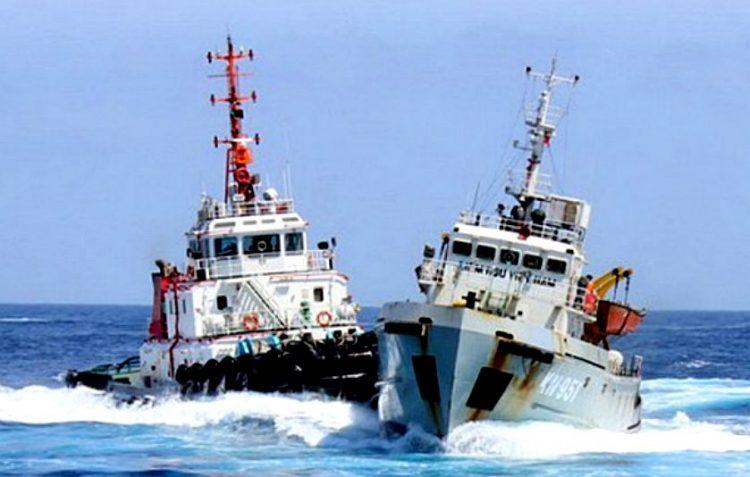Tensions in the South China Sea are once again soaring after a Vietnames fishing boat reportedly came under attack by a Chinese vessel near the contested Paracel Islands, a Vietnamese official said Friday. According to the Australian Associated Press the dangerous incident has sent tensions in the region to “a new high”.
The Vietnamese boat was fishing near Discovery Reef some 370 kilometers off Da Nang in Paracel island chain when according to Hanoi government officials it was rammed by the presumably larger Chinese vessel. The fishing boat capsized, leaving five Vietnamese crewmen clinging to the side of their upturned vessel for two hours before they were rescued by another nearby fishing boat.

Crucially, the Paracel archipelago is an intensely disputed island chain and territory, claimed by both Vietnam and China, the latter which took control of the islands in 1974. It’s known as Xisha in Chinese and Hoàng Sa in Vietnamese, and the People’s Republic of China has over the past years attempted to solidify its hold by building up reefs and artificial islands, including the construction of military installations and harbors.
This has resulted in a significant uptick in similar “ramming attack” incidents on Vietnamese boats of late. The Chinese coast guard is said to be especially active in intercepting and chasing away all non-Chinese boats, assisted in this regard by civilian boats who act as a maritime militia enforcing Chinese claims over the waters.
Over the past year more than a dozen such incidents have been reported in regional press, something that’s become commonplace enough for one analyst and east Asian affairs expert, Greg Poling at the Center for Strategic and International Studies, to comment: “China’s neighbors have become so numb to the constant exercise of low-intensity violence and intimidation that it will warrant barely a mention in regional press.”
Meanwhile, entirely to be expected Beijing had a very different version of events, according to the Associated Press:
The official Chinese Communist Party newspaper reported that a Chinese government vessel received a distress call from a Vietnamese fishing boat and sailed to the area, where it found the boat partly sunk. The online report, quoting Chinese Foreign Ministry spokesman Lu Kang, said the Chinese ship immediately contacted China’s maritime search and rescue center to dispatch a rescue vessel and the five Vietnamese fishermen were rescued.
Not only did Chinese authorities claim that no attack occurred, but they implied China was actually involved in mobilizing a rescue.
The AP report continues:
Lu said nothing about a vessel, Chinese or otherwise, ramming the Vietnamese ship other than to cite the original Vietnamese report. He also didn’t specifically say that the Chinese ship rescued the fishermen.
China’s expanding territorial claims in the South and East China Seas have sent tensions soaring with other American allies in the region as well, including the Philippines, which has recently expressed concern over increasing US “freedom of navigation” exercises and flyovers of airspace near the Chinese coast, given the potential for the Philippines to be dragged into any explosive scenario that could result in increased US-China confrontations.
For example, on Monday of this week two US Air Force B-52H Stratofortress long-range bombers took off from Guam and entered disputed airspaces of the South and East China seas to conduct “routine training missions” — as confirmed by US Air Force official statements.
China has routinely condemned such operations as dangerous provocations, in some cases communicating dire warnings to American planes or ships to depart “Chinese territory”.
Chinese ship reportedly rams and sinks a Vietnamese fishing boat in the Paracels (again). China’s neighbors have become so numb to the constant exercise of low-intensity violence and intimidation that it will warrant barely a mention in regional press. https://t.co/fgumeS3MXR
— Greg Poling (@GregPoling) March 7, 2019
In a rare statement issued Tuesday, the Philippines’ top defense official, Defense Secretary Delfin Lorenzana, warned that increased US activity in the region could spark unnecessary tensions possibly leading to war with China.
He said the Philippines-US Mutual Defense Treaty (MDT) runs the risk of causing “confusion and chaos during a crisis,” especially as the US ramps ups such aerial patrols of the region and “freedom of navigation” exercises.
“The Philippines is not in a conflict with anyone and will not be at war with anyone in the future. But the United States, with the increased and frequent passage of its naval vessels in the West Philippine Sea, is more likely to be involved in a shooting war. In such a case and on the basis of the MDT, the Philippines will be automatically involved,” Lorenzana said, according to CNN Philippines, using the local term for the South China Sea (the West Philippine Sea).
The United States, for its part, has long held its operations, even when sailing close to disputed islands claimed by China or flying overhead, are intended to assert that the area is international waters and in international airspace.
via ZeroHedge News https://ift.tt/2NQxT4K Tyler Durden
